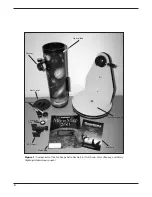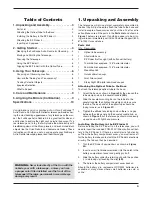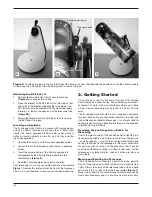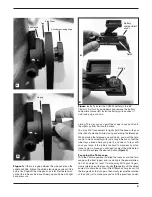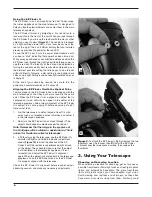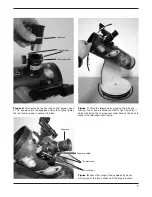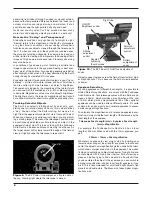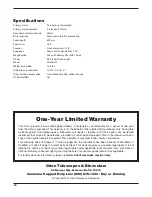
8
observing from indoors through an open (or closed) window,
because the temperature difference between the indoor and
outdoor air will cause image blurring and distortion. If at all
possible, escape the light-polluted city sky and head
for darker country skies. You’ll be amazed at how many
more stars and deep-sky objects are visible in a dark sky!
How are the “Seeing” and transparency?
Atmospheric conditions vary significantly from night to night.
“Seeing” refers to the steadiness of the Earth’s atmosphere
at a given time. In conditions of poor seeing, atmospheric
turbulence causes objects viewed through the telescope to
“boil”. If, when you look up at the sky with your unaided eyes,
the stars are twinkling noticeably, the seeing is bad and you
will be limited to viewing with low powers (bad seeing affects
images at high powers more severely). Planetary observing
may also be poor.
In conditions of good seeing, star twinkling is minimal and
images appear steady in the eyepiece. Seeing is best over-
head, worst at the horizon. Also, seeing generally gets better
after midnight, when much of the heat absorbed by the Earth
during the day has radiated off into space.
Especially important for observing faint objects is good “trans-
parency” -- air free of moisture, smoke, and dust. All of these
tend to scatter light, which reduces an object’s brightness.
Transparency is judged by the magnitude of the faintest stars
you can see with the unaided eye, e.g., 5th or 6th magnitude
is desirable. Magnitude is a measure of an object’s brightness.
The brighter a star is, the lower its magnitude will be. Consult
our online monthly star chart for magnitudes of specific stars.
tracking celestial Objects
The Earth is constantly rotating about its polar axis, com-
pleting one full rotation every 24 hours; this is what defines
a “day”. We do not feel the Earth rotating, but we see it at
night from the apparent movement of stars from east to west.
When you observe any astronomical object, you are watch-
ing a moving target. This means the telescope’s position must
be continuously adjusted over time to keep an object in the
eyepiece’s field of view. This is easy to do with the FunScope
Astro Dazzle 4.5 because it moves smoothly in both axes. As
the target object drifts slowly toward the edge of the field of
view, just lightly nudge the telescope to re-center it.
Figure 9.
The EZ Finder II superimposes a tiny red dot on
the sky, showing right where the telescope is aimed.
Red dot
Objects appear to move across the field of view faster at high-
er magnifications. This is because the field of view becomes
narrower.
Eyepiece Selection
By using eyepieces of different focal lengths, it is possible to
attain different magnifications, or powers, with the FunScope
Astro Dazzle 4.5. Your telescope comes with two Kellner eye-
pieces: a 25mm, which provides a magnification of 20x, and
a 10mm, which yields a magnification of 50x. Other, optional
eyepieces can be used to achieve different powers. It is quite
common for an observer to own several eyepieces to access
a wide range of magnifications.
To calculate the magnification of a telescope-eyepiece com-
bination, simply divide the focal length of the telescope by the
focal length of the eyepiece.
Telescope Focal Length (mm) ÷ Eyepiece Focal Length
(mm) = Magnification
For example, the FunScope Astro Dazzle 4.5 has a focal
length of 500mm. When used with the 10mm eyepiece, you
get:
500mm ÷ 10mm = 50x magnification
Whatever you choose to view, always start by inserting your
lowest-power (longest focal length) eyepiece to locate and
center the object. Low magnification yields a wide field of view,
which shows a larger area of sky in the eyepiece. This makes
finding and centering an object much easier. Trying to find and
center objects with a high power (narrow field of view) eye-
piece can be like trying to find a needle in a haystack! Once
you’ve centered the object in the eyepiece, you can switch to
a higher magnification (shorter focal length) eyepiece, if you
wish. This is recommended for small and bright objects, like
planets and double stars. The Moon also takes higher magni-
fications well.
Figure 10.
The EZ Finder II’s On/Off and adjustment
knobs.
ON/OFF
Brightness control
Altitude
adjustment
control
Dovetail
tightening
thumb screws
Azimuth
adjustment
control
Battery
compartment
cover
Sight tube


